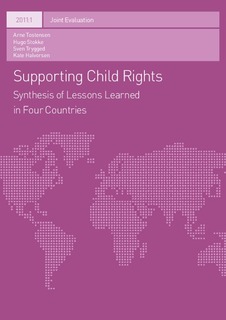| dc.description.abstract | This evaluation was commissioned jointly by the Norwegian Agency for Development Cooperation (Norad) and the Swedish International Development Cooperation Agency (Sida) with the dual purpose of: (a) summarising results achieved in order to account for the efforts and resources invested by Norway and Sweden in development co-operation in support of child rights; and (b) contributing to continuous learning and development of policies, strategies and methods based on the lessons learned derived from the experiences of Norwegian aid authorities – including the Ministry of Foreign Affairs (MFA) and Norad – and Sida, in promoting child rights. The findings from four country case studies – Guatemala, Kenya, Mozambique andSudan – underpin the conclusions and recommendations.
The evaluation was conducted by a core team comprising Arne Tostensen (team leader), Kate Halvorsen, Hugo Stokke, and Sven Trygged. In addition, each country case study was undertaken by country teams: Guatemala (Claudia Barrientos, Virgilio Álvarez Aragón and John McNeish); Kenya (Arne Tostensen and Jane Amiri); Mozambique (Kate Halvorsen,Minna Tuominen and Carmeliza Rosario); and Sudan (Liv Tønnessen and Samia al-Nagar). After an intial mapping of portfolios, field work was conducted during the period from May until August 2010. The Guatemalastudy was adversely affected by natural calamities such as a volcano eruption and a tropical storm that caused an emergency in the country.
Main findings and conclusions
Interventions supporting child rights should reflect the four main principles of the Convention on the Rights of the Child (CRC): (i) non-discrimination; (ii) the right to life, survival and development; (iii) the right to express views and be heard; and (iv) the best interest of the child. A child rights perspective is integrated to the extent that interventions embody these principles.
The principle of non-discrimination addr | |
